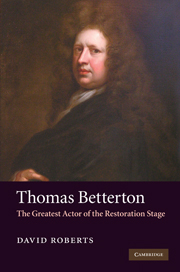Book contents
- Frontmatter
- Dedication
- Contents
- List of illustrations
- Acknowledgements
- Note on dates and texts
- Chapter 1 Introduction
- Chapter 2 Look, my lord, it comes
- Chapter 3 An obstinately shadowy Titan
- Chapter 4 An actor of London: early years, 1635–1659
- Chapter 5 A walk in the park
- Chapter 6 In the Duke’s Company, 1660–1663
- Chapter 7 Equal with the highest
- Chapter 8 Actor management
- Chapter 9 In the Company of the Duke
- Chapter 10 Union
- Chapter 11 Back to the future
- Chapter 12 Books and pictures
- Notes
- Bibliography
- Index
Chapter 4 - An actor of London: early years, 1635–1659
Published online by Cambridge University Press: 05 July 2014
- Frontmatter
- Dedication
- Contents
- List of illustrations
- Acknowledgements
- Note on dates and texts
- Chapter 1 Introduction
- Chapter 2 Look, my lord, it comes
- Chapter 3 An obstinately shadowy Titan
- Chapter 4 An actor of London: early years, 1635–1659
- Chapter 5 A walk in the park
- Chapter 6 In the Duke’s Company, 1660–1663
- Chapter 7 Equal with the highest
- Chapter 8 Actor management
- Chapter 9 In the Company of the Duke
- Chapter 10 Union
- Chapter 11 Back to the future
- Chapter 12 Books and pictures
- Notes
- Bibliography
- Index
Summary
Betterton was a discriminatingly well travelled actor. He visited Dover, Oxford, Warwickshire and Windsor, and France perhaps twice or more. We might expect to find him touring the provinces in time of vacation or plague; instead, what survives is an idyll of him performing later in life in the Hampshire home of Kit-Cat member Richard Norton. When it came, semi-retirement meant the country house in Reading. But it was his home town that dominated his life, with good reason. Restoration theatrical seasons usually ran from late August to early May, with an average of 210 acting days and perhaps thirty different plays, in the vast majority of which he appeared. Outside six performances a week and constant rehearsals, the actorly disciplines described by Gildon probably filled up the time: studying, memorising, practising in front of a mirror. In time, he would even live over the theatre. For most of his long career, then, Thomas Betterton inhabited an area not only less than the two square miles of Restoration London, but in the two neighbourhoods of Lincoln’s Inn Fields and Dorset Street.
He was born in the summer of 1635 and baptised on 11 or 12 August in St Margaret’s Church, at the eastern end of the street where he would spend his childhood. Going west from Westminster Abbey, Tothill Street was the main thoroughfare separating St James’s Park from Tothill Fields. Two years earlier, Ralph Agas’s woodcut map of London had judged it too marginal to be fully represented, for it was semi-rural. Cattle grazed in Tothill Fields; vegetables and herbs were grown. It was a miniature leisure quarter, with horse-racing, archery, the occasional parade, bull or bear baiting and a maze, drawn by Wenceslas Hollar with some strolling, preening ladies in the foreground. The highlight of the year was 13 October: St Edward’s Fair, named for Edward the Confessor, founder of Westminster Abbey. Like Bartholomew Fair, its value to local businessmen meant that it survived the Puritan restrictions of Betterton’s later boyhood. More conventional violence did intrude – duels, muggings and justice.
- Type
- Chapter
- Information
- Thomas BettertonThe Greatest Actor of the Restoration Stage, pp. 39 - 53Publisher: Cambridge University PressPrint publication year: 2010



